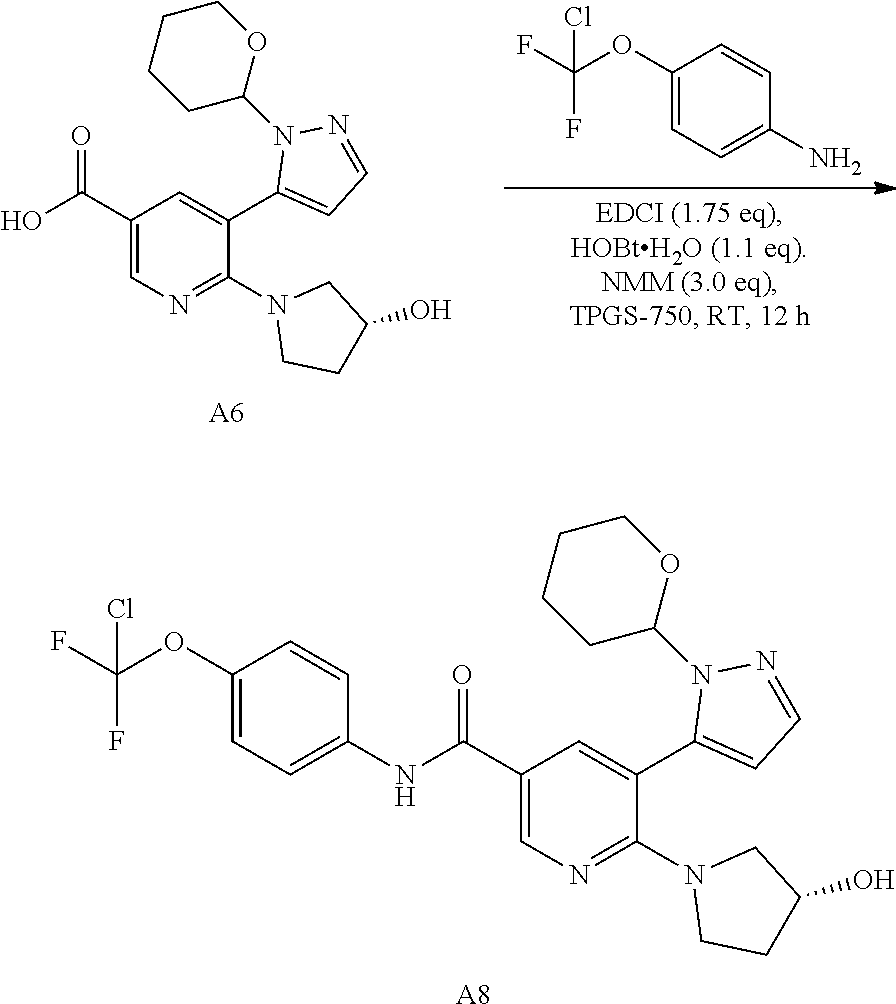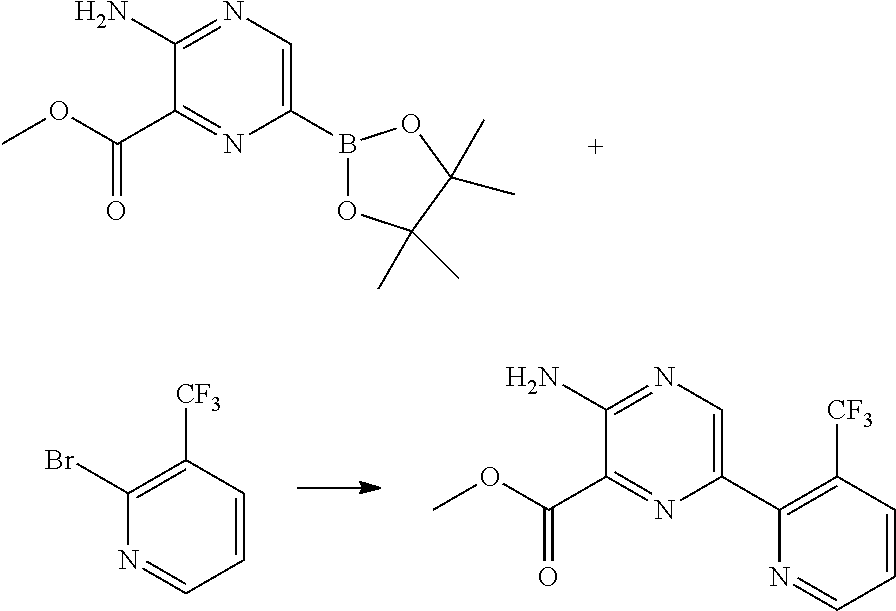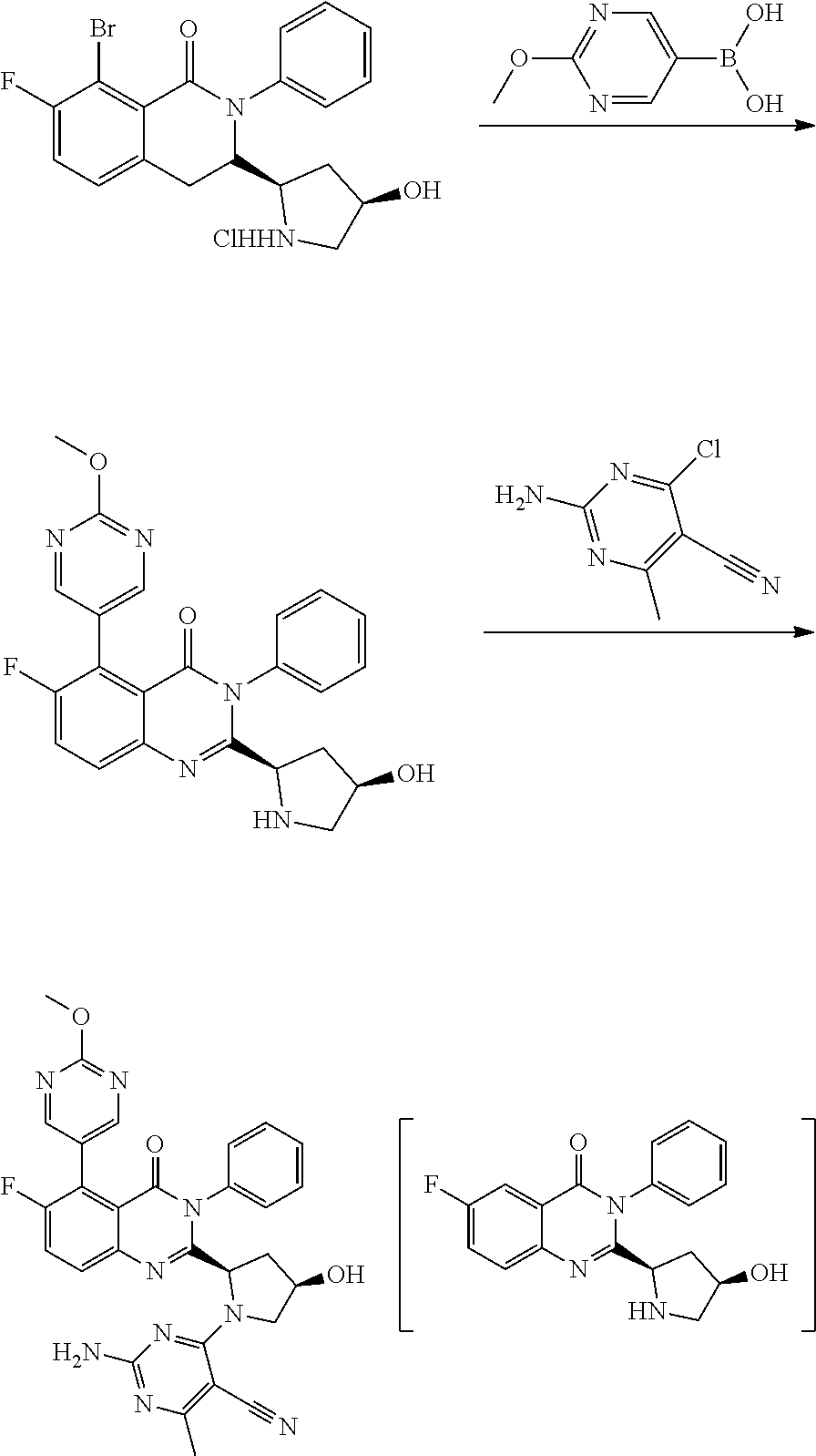Reaction medium containing water-surfactant mixture
a technology of surfactant mixture and reaction medium, which is applied in the preparation of carbamic acid derivatives, organic chemistry, and preparation of amino compounds, etc., can solve the problems of destroying the positive effect of surfactant micelles, unfavorable industrial scale or nanoscale applications, and using environmental friendly and cost-effective methods, so as to improve the yield of reaction and improve the stability/homogeneity of reaction mixtur
- Summary
- Abstract
- Description
- Claims
- Application Information
AI Technical Summary
Benefits of technology
Problems solved by technology
Method used
Image
Examples
example 1
Synthesis of N-[4-(chlorodifluoromethoxy)phenyl]-6-[(3R)-3-hydroxypyrrolidin-1-yl]-5-[1-(oxan-2-yl)-1H-pyrazol-5-yl]pyridine-3-carboxamide via Amidation Reaction
[0063]4-methylmorpholine (NMM; 3 eq, 0.85 wt), the carboxylic acid (1 eq, 1 wt)), 1-hydroxybenzotriazole hydrate (HOBT) (1.2 eq, 0.47 wt) and TPGS-750M aqueous solution 2% wt (15 wt) were charged into the vessel and stirred at RT until clear solution is formed. The solution was warmed to 35° C. A solution of 1-ethyl-3-(3-dimethylaminopropyl)carbodiimide (EDCI) (1.7 eq, 0.94 wt), the amine (1.2 eq, 0.66 wt), PEG200 (3.8 wt) in water (0.33 wt) was added sequentially over 3 h and stirred for another 16 h. Over the course of the reaction, the desired product precipitated out of the mixture. The suspension is filtered and washed with two portion of H2O / Methanol 4:1
[0064]
mixture (4 wt). The cake is dried under vacuum. A typical yield of 90% is obtained.
[0065]The absence of co-solvent such as PEG-200 results in an oiling out of the...
example 2
Synthesis of methyl 3-amino-6-[3-(trifluoromethyl)pyridin-2-yl]pyrazine-2-carboxylate via Suzuki Cross-Coupling Reaction
[0067]10.0 g (44.2 mmol) of 2-bromo-3-(trifluoromethyl)pyridine and 18.5 g (53.1 mmol / 1.2 eq.) of methyl 3-amino-6-(4,4,5,5-tetramethyl-1,3,2-dioxaborolan-2-yl)pyrazine-2-carboxylate was provided in a reaction mixture comprising 3.0 mol % [1,1′-bis(di-tert-butylphosphino)ferrocene]dichloropalladium(II) (PdCl2(dtbpf)) and 2.0 eq. triethylamine (TEA) in 150 ml (15V) 2% TPGS-750-M in water and 30 ml (2V) tetrahydrofuran (THF). The reaction mixture formed a stable emulsion and the reaction was allowed to proceed overnight at room temperature under stirring. The product 3-amino-6-[3-(trifluoromethyl)pyridin-2-yl]pyrazine-2-carboxylate was obtained with a yield of more
[0068]
than 80%.
[0069]The same reaction using 10V 2% TPGS-750-M in water and 10V acetone as solvents, wherein 1.05 eq. methyl 3-amino-6-(4,4,5,5-tetramethyl-1,3,2-dioxaborolan-2-yl)pyrazine-2-carboxylate was...
example 3
Synthesis of 2-amino-4-((2S,4S)-2-(6-fluoro-5-(2-methoxypyrimidin-5-yl)-4-oxo-3-phenyl-3,4-dihydroquinazolin-2-yl)-4-hydroxypyrrolidin-1-yl)-6-methylpyrimidine-5-carbonitrile via Suzuki Cross-Coupling Reaction and Aromatic Nucleophilic Substitution Reaction
[0070]In this example, two different synthesis reactions were performed subsequently in one reaction vessel without exchange of the reaction medium.
[0071]5.0 g (11.3 mmol) of 5-bromo-6-fluoro-2-((2S,4S)-4-hydroxypyrrolidin-2-yl-3-phenylquinazolin-4(3H)-one hydrochloride and 1.9 g (12.5 mmol / 1.1 eq.) of (2-methoxypyrimidin-5-yl)boronic acid was provided in a reaction mixture comprising 5.0 mol % PdCl2(dtbpf) and 3.0 eq. NMM in 40 ml (8V) 2% TPGS-750-M in water and 20 ml (4V) THF. The reaction mixture formed a stable emulsion and the reaction was allowed to proceed for 16 h at 50° C. under stirring. Then 1.7 g (10.2 mmol / 0.9 eq.) of 2-amino-4-chloro-6-methylpyrimidine-5-carbonitrile in 10 ml (2V) THF were added to the reaction mixtu...
PUM
| Property | Measurement | Unit |
|---|---|---|
| volume | aaaaa | aaaaa |
| volume | aaaaa | aaaaa |
| temperature | aaaaa | aaaaa |
Abstract
Description
Claims
Application Information
 Login to View More
Login to View More - R&D
- Intellectual Property
- Life Sciences
- Materials
- Tech Scout
- Unparalleled Data Quality
- Higher Quality Content
- 60% Fewer Hallucinations
Browse by: Latest US Patents, China's latest patents, Technical Efficacy Thesaurus, Application Domain, Technology Topic, Popular Technical Reports.
© 2025 PatSnap. All rights reserved.Legal|Privacy policy|Modern Slavery Act Transparency Statement|Sitemap|About US| Contact US: help@patsnap.com



